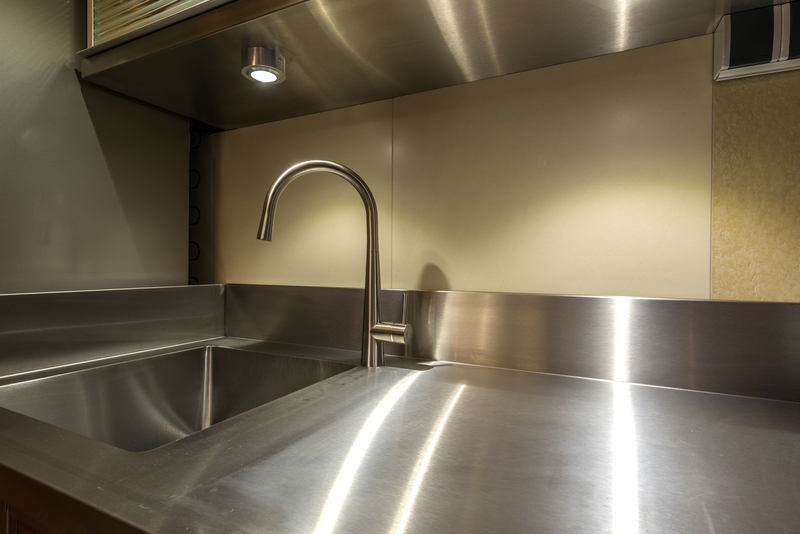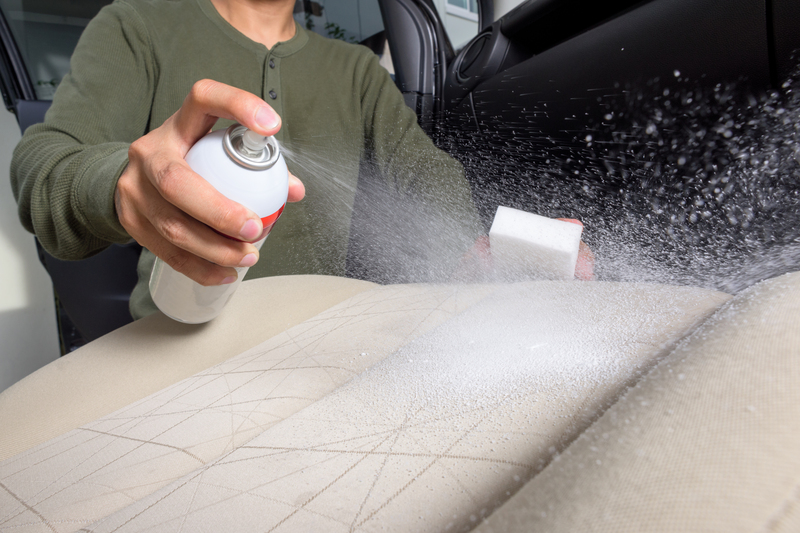Unveil the Science of Perfect Car Cleaning Done by Pros
Posted on 03/06/2025
Unveil the Science of Perfect Car Cleaning Done by Pros
Have you ever wondered why your car looks so much more spectacular after a professional detailing session compared to a quick wash at home? *The secret isn't simply elbow grease or expensive products; it's the science-backed techniques experts use to achieve that showroom shine*. In this comprehensive guide, we will delve deep and unveil the science of perfect car cleaning done by pros, explore industry secrets, and teach you how to transform your vehicle using pro-level strategies.

Why Science Matters in Professional Car Cleaning
When it comes to car detailing and cleaning, professionals rely on principles of chemistry, physics, and material science. Understanding how different contaminants interact with surfaces, which cleaning agents work best, and how mechanical actions affect results, is crucial.
- Advanced cleaning methods rely on pH balance to avoid damaging paint.
- Modern microfiber technology ensures minimal scratching and maximum pickup of dirt.
- Foam cannon and two-bucket wash techniques reduce swirl marks during the active cleaning phase.
*Ultimately, the science of perfect car cleaning intertwines product choice, method, and environmental considerations to deliver that eye-catching result.*
The Professional Car Cleaning Process: Step by Step
If you want lasting shine and paint protection, it's crucial to follow each stage diligently. Top car cleaning specialists follow a scientifically informed routine, ensuring every aspect of vehicle care is covered.
1. Pre-Wash and Inspection
- Inspection: Experts begin by closely inspecting the car for dirt, debris, and any suspected areas of damage.
- Pre-rinsing: High-pressure water rinses off loose soil particles, preventing scratches during the wash.
This phase reflects a *scientific principle: reduce as much loose dirt as possible to minimize abrasion during mechanical washing*.
2. Decontamination: Removing Bonded Contaminants
- Iron Fallout Removers: Chemically dissolve metallic particles such as brake dust clinging to the paint.
- Tar & Bug Removers: Break down organic residues for easier cleaning.
The application of these products is all about chemistry--using the right pH level and active ingredients to target specific contaminants without harming the finish.
3. Snow Foam Pre-Soak
- Encapsulation and Lubrication: Applying a thick foam lifts and encapsulates dirt particles, suspending them above the surface.
- Reduced Swirl Marks: Foam acts as a buffer, significantly reducing abrasive contact.
*This step is crucial in the science of perfect car cleaning, as it provides extra safety before any physical contact with the paint occurs*.
4. The Two-Bucket Washing Method
- Wash Bucket: Contains soapy water.
- Rinse Bucket: Water for cleaning the wash mitt after each pass.
The rationale? *By rinsing the mitt continually, contaminants are not reintroduced to the car's paint, thus minimizing chances of scratching*.
Pro tip: Always use a high-quality, soft microfiber mitt. Microfibers are engineered with *wedge-shaped fibers* that grab and remove dirt effectively.
5. Wheel and Tire Cleaning
- Specialty Brushes: Pros use non-abrasive wheel brushes to reach into intricate areas.
- pH Balanced Cleaners: Protect wheel finishes while thoroughly removing brake dust and road grime.
Dedicated products protect the sensitive surfaces of wheels and tires, enhancing longevity and maintaining appearance.
6. Paint Decontamination with Clay Bar
- Clay Bar Treatment: Removes stubborn contamination such as industrial fallout and sap.
*Professional detailers glide a lubricated clay bar over the paint, which acts like a magnet for microscopic contaminants, ensuring a glass-smooth finish before polishing or waxing.*
The Role of Chemistry in Car Cleaning Products
Understanding the chemistry behind car cleaning products gives professionals a significant edge. Here are the most commonly used types of products and how they work:
- Surfactants: These are the backbone of car shampoos. They reduce surface tension, loosening dirt and emulsifying oils so they can be rinsed away safely.
- pH-Neutral Cleaners: Used on sensitive surfaces to prevent etching or discoloration.
- Acidic and Alkaline Cleaners: Employed only when necessary (e.g., in heavy-duty wheel cleaners), always with care.
- Solvent-Based Cleaners: Essential for removing tar and tough grease.
*Choosing the appropriate product based on material and contamination type is key--the science of car cleaning done by pros is all about optimizing cleaning power without damaging delicate surfaces.*
Secrets Behind a Perfectly Cleaned Car Interior
The science of perfect car cleaning isn't just about the exterior. The interior demands attention to detail and scientific know-how:
- Vacuuming: High-power extractors remove dirt from deep within fibers and crevices.
- Steam Cleaning: Uses the power of heat (physics!) to loosen embedded dirt without heavy chemicals.
- pH-Balanced Upholstery Cleaners: Prevent stains and wear on seats and headliners.
*Fact:* Steam vapor also kills bacteria and germs, offering a sanitized, fresh-smelling cabin.
Drying Methods: How Pros Avoid Paint Damage
Washing is only half the battle. Pros know critical damage can occur during drying if not performed properly. Here's why:
- Microfiber Towels: With hundreds of thousands of fine fibers per square inch, these towels gently absorb water, vastly superior to old-school chamois or bath towels.
- Touchless Drying: Utilizing filtered air blowers, pros dry areas prone to water spotting--like mirrors and emblems--without any physical contact.
- Quick Drying: Prevents minerals in water from etching or spotting the finish.
This drying science helps maintain a swirl-free finish and preserves the results of professional cleaning for longer.
Polishing: The Art and Science Combined
After cleaning, professional detailers refine the finish through a careful process known as paint correction. This blends artistry with cutting-edge scientific understanding:
- Machine Polishers: Random orbital or dual-action polishers provide consistent, safe abrasion without burning or marring the paint.
- Abrasive Compounds: Scientifically formulated to level microscopic peaks and valleys, minimizing scratches and reinstating gloss.
- Multiple Stages: From heavy-cutting compounds to ultra-fine finishing polishes, each step uses abrasives of decreasing coarseness.
*The science here?* Proper heat management and pad choice, ensuring the material is corrected but never overheated or worn through.
Protection: The Final Step in Pro Car Cleaning
Once your car is clean and polished, the final step in the science of professional car cleaning is applying protection. Pros invest in high-level paint sealants, waxes, or even ceramic coatings. How do these work?
- Carnauba Wax: Offers deep gloss and a water-repellent surface, but needs reapplication every few months.
- Paint Sealants: Synthetically engineered molecules bond tightly to paint, providing months of protection from UV, acid rain, and contaminants.
- Ceramic Coatings: Use nanotechnology to create a semi-permanent, ultra-hydrophobic barrier that lasts for years. These coatings resist chemical damage, UV rays, and makes cleaning much easier.
*Science fact:* Ceramic coatings resist chemical etching, water spotting, oxidation, and impart a visible candy-gloss effect that is unmistakable even at a distance.
Professional Tools That Make All the Difference
It's not just technique--the equipment used by professional car cleaners sets them apart. Here's what you'll find in a pro's arsenal:
- Dual-Action Polishers & Foam Pads: For safe, consistent paint correction.
- Filtered Water Systems: Removes minerals, guaranteeing a spot-free final rinse.
- Paint Thickness Gauges: Used to ensure safe levels of correction can be performed without risking through-burn on thin paint.
- Professional Grade Steam Cleaners: For deep cleaning and sanitizing vehicle interiors.
*When it comes to auto detailing, having the right tools isn't a luxury--it is a necessity for consistent, safe, and stunning results.*
The Environmental Edge of Modern Professional Car Cleaning
Sustainability is no longer a buzzword. The science of car cleaning now emphasizes eco-friendly solutions:
- Low-water or waterless wash systems for drought-affected regions.
- Biodegradable cleaning agents protect waterways and wildlife.
- Microfiber technology reduces reliance on harsh, single-use materials.
*Pro tip:* Always responsibly dispose of contaminated wash water and chemicals to help protect the environment.
Common Mistakes to Avoid (and How The Pros Handle Them)
Not all cleaning is equal. Here are typical mistakes DIYers make--and how professionals dodge them using scientific approaches:
- Skipping Pre-Rinse: This increases swirl and scratch risk. Always pre-rinse thoroughly.
- Wrong Product Choices: Acidic wheel cleaners on uncoated aluminum, for example, can etch and stain. Pros always use pH-appropriate solutions.
- Improper Tools: Household sponges and old towels trap grit and scratch paint. Professionals invest in *grit guards, microfiber mitts, and high-quality towels*.
- Neglecting Hidden Areas: Under-hood cleaning, door jambs, and trim need equal attention for a true "perfect" clean.
*By integrating scientific best practices, the gap between DIY and professional results becomes crystal clear.*

Why Choose Professional Car Cleaning? The Real-World Benefits
Many car owners ponder: is the investment in professional detailing worth it? The answer lies in the benefits:
- Paint Preservation: Routine scientific cleaning dramatically reduces scratches and swirls, preserving paint longevity.
- Resale Value: A regularly detailed car fetches a higher price and is more attractive to buyers.
- Health: Interior cleaning removes allergens and pathogens, providing a healthier environment for you and your family.
- Time Savings: Professionals clean efficiently and thoroughly, freeing your weekends for fun rather than chores!
When you trust your vehicle to the science of perfect car cleaning done by pros, you aren't just getting a clean car--you're investing in protection, health, and years of head-turning style.
Conclusion: Embrace the Science of Professional Car Cleaning
The dazzling results you see on freshly detailed vehicles are no accident. The science of perfect car cleaning done by pros is a blend of advanced products, evidence-based techniques, and world-class tools. By understanding--and perhaps even adopting--some of these methods at home, you can elevate your own car care, safeguard your investment, and enjoy that jaw-dropping, just-detailed look every day.
Unlock the power of automotive science today, and let your car's brilliance shine for years to come!




